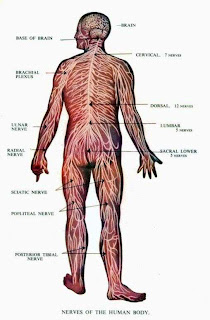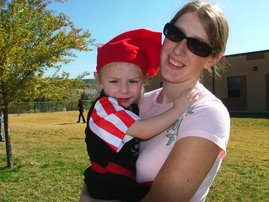
Unit III Compendium Review 1
• What does the nervous system do?
• Diffusion and Action Potentials in Neurons--
rapid transmission of messages
• Reflex arc (simple somatic function)
and autonomic function
• What can we sense?
(Picture of the nerves in a humane body.)
What does the nervous system do:
There are two parts to the nervous system; the central nervous system (CNS) and the peripheral nervous system (PNS). The central nervous system is the made up of the brain and the spinal cord. The peripheral nervous system is the nerves that run threw out the human body. The CNS receives input or signals and sends messages to the nerves in the PNS to function or react. So if you stub your toe the nerves in your toe send a ouch message up your spinal chord to your brain. The nervous system doesn’t only send pain messages. It can send any kind of massage hot, cold, soft or hard. Or nerves system lets our brain know what is going on.

(Here is a picture of an axon. Notice the enlarged picture in the corner, this is a axon terminal.)
• What does the nervous system do?
• Diffusion and Action Potentials in Neurons--
rapid transmission of messages
• Reflex arc (simple somatic function)
and autonomic function
• What can we sense?
(Picture of the nerves in a humane body.)
What does the nervous system do:
There are two parts to the nervous system; the central nervous system (CNS) and the peripheral nervous system (PNS). The central nervous system is the made up of the brain and the spinal cord. The peripheral nervous system is the nerves that run threw out the human body. The CNS receives input or signals and sends messages to the nerves in the PNS to function or react. So if you stub your toe the nerves in your toe send a ouch message up your spinal chord to your brain. The nervous system doesn’t only send pain messages. It can send any kind of massage hot, cold, soft or hard. Or nerves system lets our brain know what is going on.
(This is a picture of of a myelin sheath on an axon.)
Diffusion and action potentials in neurons, rapid transmission of messages:
Neurons are transmitter cells that send signals threw out the nervous system. Neurons are the main cells in our brains; they don’t divide like other cells. Action potential is the processes of sending a message down a nerve. An action potential is the same thing as a nerve impulse. Nerve impulses travel 1.0 m/second – 100m/second. This speed in sending an impulse is so fast that it’s amazing. These impulses are sent down a nerve fiber or axon. Axons conduct nerve impulses. Long axons usually have a protective covering called Schwann cells. It is a myelin liquid substance. It does not cover the whole axon; it covers with gaps in between each one. The gapes are called nodes of Ravier. Myelin sheaths have several purposes, they insulate and they help regenerate new fiber growth if there is damage to the axon. When an axon has a myelin sheath the action potential is sent from Ranvier node to Ranvier node. Axons have many branches at the end of the branches are axon terminals. These are right next to other neurons. The space between them is called the synaptic cleft. This gap separates sending and receiving neurons. Instead there are molecules called neurotransmitters that carry messages a crossed. These neurotransmitters are kept inside the axon terminal.
Diffusion and action potentials in neurons, rapid transmission of messages:
Neurons are transmitter cells that send signals threw out the nervous system. Neurons are the main cells in our brains; they don’t divide like other cells. Action potential is the processes of sending a message down a nerve. An action potential is the same thing as a nerve impulse. Nerve impulses travel 1.0 m/second – 100m/second. This speed in sending an impulse is so fast that it’s amazing. These impulses are sent down a nerve fiber or axon. Axons conduct nerve impulses. Long axons usually have a protective covering called Schwann cells. It is a myelin liquid substance. It does not cover the whole axon; it covers with gaps in between each one. The gapes are called nodes of Ravier. Myelin sheaths have several purposes, they insulate and they help regenerate new fiber growth if there is damage to the axon. When an axon has a myelin sheath the action potential is sent from Ranvier node to Ranvier node. Axons have many branches at the end of the branches are axon terminals. These are right next to other neurons. The space between them is called the synaptic cleft. This gap separates sending and receiving neurons. Instead there are molecules called neurotransmitters that carry messages a crossed. These neurotransmitters are kept inside the axon terminal.

(Here is a picture of an axon. Notice the enlarged picture in the corner, this is a axon terminal.)
Reflex arc (simple somatic function) and autonomic function:
The nerves in the somatic system serve the skin, skeletal muscles and tendons. (Mader 263) The reflex arc is a response to a stimulus. This could be responding to pain or to the pleasant smell of a flower. If its pain your nerves send a message to your spinal chord and up to your brain to move or jump back and react. For example if you burn yourself you automatically jump back o pull your arm away from the stove. The autonomic function is automatic operation of your organs. You don’t have to tell your heart to pump or your stomach to digest food. The autonomic system regulates them to keep them going as there suppose to.
The nerves in the somatic system serve the skin, skeletal muscles and tendons. (Mader 263) The reflex arc is a response to a stimulus. This could be responding to pain or to the pleasant smell of a flower. If its pain your nerves send a message to your spinal chord and up to your brain to move or jump back and react. For example if you burn yourself you automatically jump back o pull your arm away from the stove. The autonomic function is automatic operation of your organs. You don’t have to tell your heart to pump or your stomach to digest food. The autonomic system regulates them to keep them going as there suppose to.
(This is a picture of skin, notice the nerves in the skin.)
What can we sense:
Our bodies have sensory receptors that detect stimuli, things like smells tastes and sounds. Exteroceptors detect things that happen to the outside of our bodies. Interceptors detect things going on inside our bodies like blood pressure. There are four kinds of sensory receptors chemoreceptors, pain receptors, photoreceptors and mechanoreceptors. Chemoreceptors detect taste and smell they also monitor blood ph inside the carotid arteries and the aorta. Pain receptors alert use to danger. They let us know when we are pushing or bodies to hard or when we are touching something sharp or hot. Photoreceptors provide us with our vision they sense light and colors. Mechanoreceptors detect gravity, motion and help us maintain our balance. Sensory receptors send messages to our brain that lets us know what we are experiencing. Our senses control all kinds of things. They let us know where are limbs are meaning we can close our eyes and still know what we are doing with our limbs. Our skin can sense touch good or bad. We taste things because we have thousands of little tiny taste buds that sense the different flavors. We also smell things while we taste them, so we can associate a good smell with something that also tastes good. We can also detect bad smells like when food is rotten. Our vision might be one of our most important senses. We can see things coming and respond by getting out of the way of danger. Our hearing helps us communicate and also lets us hear things coming like if we are crossing the street and hear a truck coming. All of these senses send nerve impulses to our spinal cord and up into our brain so that we can respond.
Our bodies have sensory receptors that detect stimuli, things like smells tastes and sounds. Exteroceptors detect things that happen to the outside of our bodies. Interceptors detect things going on inside our bodies like blood pressure. There are four kinds of sensory receptors chemoreceptors, pain receptors, photoreceptors and mechanoreceptors. Chemoreceptors detect taste and smell they also monitor blood ph inside the carotid arteries and the aorta. Pain receptors alert use to danger. They let us know when we are pushing or bodies to hard or when we are touching something sharp or hot. Photoreceptors provide us with our vision they sense light and colors. Mechanoreceptors detect gravity, motion and help us maintain our balance. Sensory receptors send messages to our brain that lets us know what we are experiencing. Our senses control all kinds of things. They let us know where are limbs are meaning we can close our eyes and still know what we are doing with our limbs. Our skin can sense touch good or bad. We taste things because we have thousands of little tiny taste buds that sense the different flavors. We also smell things while we taste them, so we can associate a good smell with something that also tastes good. We can also detect bad smells like when food is rotten. Our vision might be one of our most important senses. We can see things coming and respond by getting out of the way of danger. Our hearing helps us communicate and also lets us hear things coming like if we are crossing the street and hear a truck coming. All of these senses send nerve impulses to our spinal cord and up into our brain so that we can respond.
(This is an ear, part of our senses.)
(This is a picture of the human eye, another one of or senses.)
Work Cited:
Madder, Sylvia S. “Human Biology” 10th ed. New York: McGraw-Hill, 2007.
Madder, Sylvia S. “Human Biology” 10th ed. New York: McGraw-Hill, 2007.
Skin http://www.medicinenet.com/images/illustrations/skin.jpg
Ear http://www.ears-r-us.com/ear-web2_2.jpg
Eyeball http://library.thinkquest.org/12409/images/eye1.jpg
Nerve body http://www.probertencyclopaedia.com/j/Nerve.jpg
Neurons http://66.241.252.6/images/neurons.jpgNerve cells http://www.getbodysmart.com/ap/nervoussystem/celltypes/menu/image.gif
Ear http://www.ears-r-us.com/ear-web2_2.jpg
Eyeball http://library.thinkquest.org/12409/images/eye1.jpg
Nerve body http://www.probertencyclopaedia.com/j/Nerve.jpg
Neurons http://66.241.252.6/images/neurons.jpgNerve cells http://www.getbodysmart.com/ap/nervoussystem/celltypes/menu/image.gif





No comments:
Post a Comment